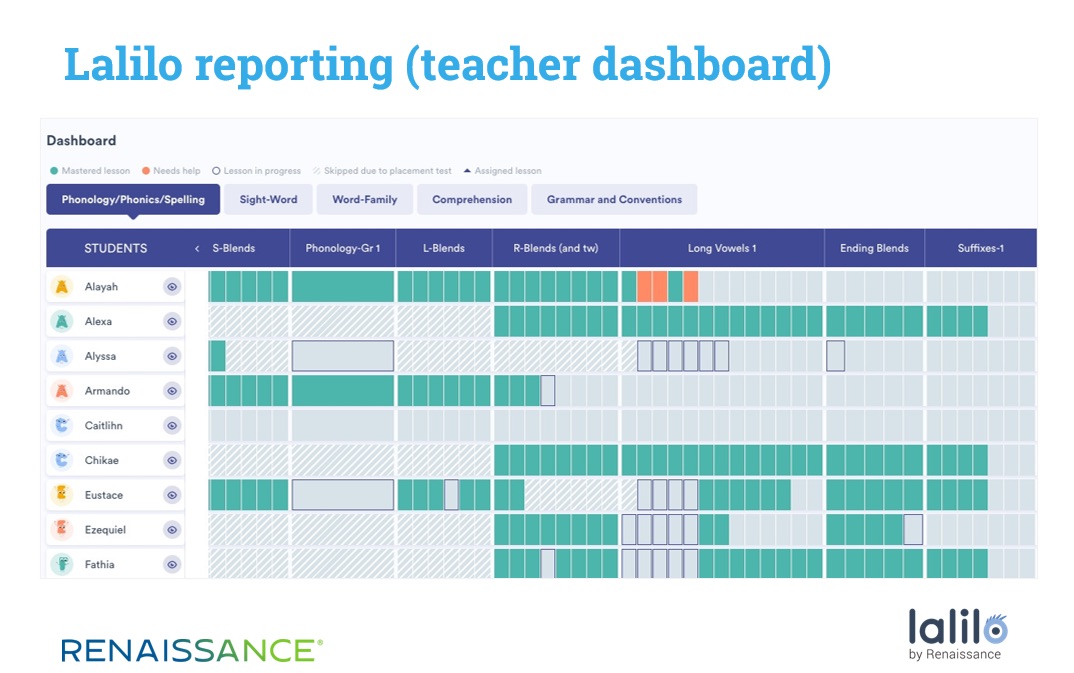August 6, 2021
For years, educators have known the importance of strong foundational literacy reading skills for lifelong learning, but they have sometimes differed on the best ways to help students acquire these skills. However, the Science of Reading has settled this argument with a large and continuously growing body of empirical studies and some elegant summaries of this research.
We now understand the importance of helping students “learn the code” for reading the English language. We often hear that systematic and explicit phonics instruction in the primary grades is the best way to assure this outcome.
In this blog, I’ll:
- Dig a bit deeper to define foundational literacy reading skills
- Introduce you to Lalilo and its important role at Renaissance
- Outline some practical approaches you can use right away to provide great instruction to all students
Foundational literacy reading skills: Making the Science of Reading practical
Let’s consider three summaries that have had a major impact on reading instruction:
The Simple View of Reading
In the 1980s, Phillip Gough and his colleagues demonstrated that reading can be described conceptually as a “mathematical” equation:
Reading = Decoding x Linguistic Comprehension
Here, two separate factors contribute to anyone’s reading skill. First, skillful reading requires linguistic comprehension, or students’ ability to understand the content they encounter. This includes the vocabulary, background knowledge, and logical inferences that are required to understand the information being presented and act on that information in ways that are meaningful to them and others.
While linguistic comprehension is necessary, it does not occur without first accessing the “raw text” or decoding—that is, matching letters and letter combinations to specific sounds and then telescoping those sounds into understandable units (Gough & Tunmer, 1986; Hoover & Gough, 1990).
This second factor, decoding, is the primary focus of foundational literacy. Of course, we must continue to provide ongoing support to improve students’ linguistic comprehension while teaching phonics, but, during the early elementary grades, a greater degree of emphasis is often given to decoding.
Scarborough’s Rope
Hollis Scarborough (2001) proposed a complementary and somewhat more detailed analysis. Her “reading rope,” shown below, parallels and adds detail to the two major components of the Simple View.
In her model, language comprehension (like “linguistic comprehension” in the Simple View) can be further defined as the student’s accumulated background knowledge, vocabulary, knowledge of language structures, verbal reasoning skills, and more general literacy knowledge.
Similarly, word recognition (like “decoding”) includes a student’s phonological awareness skills (hearing and manipulating the sounds of language), basic decoding skills (from simple letter-sound correspondence to more complex phonics rules like “silent e”), and more fluent sight recognition of both frequently encountered and phonetically irregular words.
Like the Simple View, Scarborough’s analysis makes clear that skillful reading requires competence in both of these strands of development. One strand—decoding or word recognition—is an excellent candidate for direct and systematic instruction that efficiently equips the child with perhaps the more difficult skill set for success.
The Science of Reading
In recent years, much of the content above has been captured by a new summary term: the Science of Reading. The Science of Reading draws on both basic cognitive science (e.g., Seidenberg, 2017) and applications in educational practice (e.g., Shanahan, 2020) and has been broadly discussed in the popular press (Glatter, 2016; Hanford, 2018, 2019, 2020).
Mark Seidenberg (2017) has offered a comprehensive and well-regarded survey of this science. Most relevant here, Seidenberg describes reading as a “phonological process”—that is, a pathway where readers convert the shapes that we call letters into the sounds they represent and, in turn, into the words they produce.
This allows them to “understand” these words and the passages that contain them. As he says, “The phonological pathway requires knowing how print relates to sound, the focus of ‘phonics’ instruction…. For reading scientists, the evidence that the phonological pathway is used in reading and especially important in beginning reading is about as close to conclusive as research on complex human behavior can get.”
Despite the differences in terminology, all three of these models reach a similar conclusion: Reading is a complex and demanding skill that rests necessarily on decoding;the task of turning letters on a page or a screen into words and language we can understand and act on.
As a result, decoding is foundational, and we do best when we help our students to build this solid foundation.
The Science of Reading in the classroom
Parents, educators, and policymakers have heard the message: Both research findings and the evaluation of existing educational practices point to more closely and carefully focusing on foundational literacy instruction and early reading proficiency in the early grades.
For this reason, educational standards explicitly mandate foundational literacy instruction. For example, the Common Core State Standards require “fostering students’ understanding and working knowledge of concepts of print, the alphabetic principle, and other basic conventions of the English writing system.”
At the same time, some commentators are concerned that educators have inadequate resources to ensure great foundational literacy instruction for all students (Hanford, 2018, 2019, 2020; Shanahan, 2020). This has led to a groundswell of efforts to provide teachers with both core foundational knowledge of the Science of Reading (Goldenberg et al., 2020; Moats, 2020) and access to core and supplemental instructional programs to directly support foundational literacy skill development.
Renaissance’s efforts to accelerate learning for all students have always held reading proficiency and opportunity at their core. These efforts also had at least an implicit emphasis on reading to learn—great resources and developmental experiences for emergent and proficient readers.
In recent years, growing attention to the Science of Reading has led to fuller attention to younger learners, including those not yet skillful or independent readers. Our newest product, Lalilo, builds on this expanded focus, providing systematic and explicit phonics supplemental instruction that closely reflects what we know from the Science of Reading.
Lalilo: The free online foundational literacy reading skills program
Recently, Renaissance added an important resource for teachers’ instructional toolkits. Lalilo, a free, online foundational literacy reading skills program designed to help K–2 students master phonics skills, will help teachers to:
- Expand their reach to individual students
- Deepen their instruction where those students need it most
- Accomplish more instructionally than might otherwise be possible
Lalilo’s arrival in US schools is particularly timely, given two recent events that impact how we think about early-grades students returning to the classroom this fall.
First, schools have been intensifying their focus on learning to read—and on systematic and explicit phonics instruction and a “foundational literacy reading skills” approach. This prepares all students to become independent scholars so they can read to learn as they reach the upper elementary grades and beyond.
Foundational literacy represents the bedrock skills, experiences, and instructional practices that prepare students for reading proficiency and—as a result—for later academic and life success.
Second, we know we’ll face deep and varied instructional needs this fall, and likely for some time thereafter. Evidence suggests that the COVID-19 disruptions affected learning trajectories for all students, particularly for those who were already struggling or had other risk factors when the building closures began.
Further, we know that the idea no longer holds that all 5-year-olds will be enrolled in kindergarten, all 6-year-olds will be enrolled in first grade, and so on. Especially in the early grades, there are some children whose parents delayed their school start and other children who were nominally enrolled but barely engaged, perhaps doubly challenging these children’s preparation for the typical content of their assigned grade this year.
When we put these two factors together, we realize that now is the time for vigorous, creative, and differentiated instruction that meets the needs of each student we serve. We want to face these challenges and plan for success.
Introducing Lalilo for foundational literacy skills practice
So, what is Lalilo? In the simplest terms, Lalilo is a standards-aligned, developmental program that helps teachers to build essential foundational literacy skills for their students, especially in K–2.
Lalilo accomplishes this by providing high quality, differentiated instruction. Lalilo covers eight important domains of learning:
- Phonemic awareness
- Letter recognition
- Letter-sound correspondence
- Blending
- Segmenting
- Decoding whole words
- Fluency in word recognition
- Comprehension
Lalilo provides students with engaging exercises, activities, and lessons and marks each student’s progress by providing access to both more challenging content and engaging, enjoyable stories and activities. It also provides tools for integrating with other instructional resources, giving teachers data they need to monitor students’ progress and develop plans for ongoing assessment and instruction.
They can reassign Lalilo lessons, embed related content into large- and small-group teacher-directed lessons, and share information on individual students’ progress with other educators.

Lalilo uses the power of technology to support students’ foundational literacy reading skills development. The instructional sequence is adaptive, changing to repeat lessons and strengthen skills the child has not yet mastered.
The program also employs the latest in speech recognition resources to provide speedy and precise feedback to students as they move through progressively more difficult activities.
Through its…
- Solid basis in sound pedagogical design and implementation for early reading
- Engaging design
- Individualized and adaptive activities, and
- Instructionally relevant reporting
… Lalilo provides a supplemental foundational literacy reading skills instructional program that will fit any K–2 classroom and will help you to ensure that students gain the necessary skills to become independent, proficient readers.

Accelerating foundational literacy reading skills development this fall—and beyond
While it would be a welcome resource any year, Lalilo really shines given the demands teachers face right now: the need to provide high-quality, intensive, and differentiated instruction to make up lost ground due to the COVID-19 pandemic.
Lalilo does this by providing each student with an easy-to-access, easy-to-use account that:
- First asks them to complete a simple set of tasks to both introduce them to the Lalilo worlds, and
- To gather information that determines each student’s best starting place in the program’s scope and sequence
Lalilo provides resources that can be used by all students in a classroom, or by those requiring supplemental intervention. Further, while we hope the upcoming school year will be safe and stable, with teachers and students together in the classroom, Lalilo can be used in at-home or hybrid learning models to provide instruction for continuous learning and achievement.
Lalilo is also a perfect companion to our Star Assessments, helping teachers to answer “What’s next?” for students with lower seasonal screening scores.
As a result, we have assessment and analysis resources that help us produce a promising and easy-to-implement three-step plan by pairing Lalilo with Star:
- Seasonal screening and benchmark evaluation. Star CBM Reading and Star Early Literacy provide efficient ways to assess reading skills for all students in a class and to do so seasonally in fall, winter, and spring. These measures also provide scientifically based benchmarks of proficiency that allow teachers to quickly identify students who are struggling—so they can see where Lalilo is particularly needed.
- Resources to set individual goals. Teachers can use Star CBM Reading or Star Early Literacy to set goals for students scoring below established benchmarks, using their professional expertise to establish an ambitious yet reasonable goal for each student’s future achievement.
- Progress monitoring. Once students have started using Lalilo, teachers can monitor their progress with the program’s helpful reports and dashboards. Teachers can check whether students are using Lalilo as much as intended and whether they are completing activities and lessons at a desired pace. Teachers can also get an external check on the impact of Lalilo’s instruction by completing additional Star CBM or Star Early Literacy assessments and comparing those results to grade-level norms and goals set for that student. This ongoing picture of growth in foundational literacy reading skills helps teachers to adjust and provide the “just right” instruction for each student.
It’s easy to imagine two scenarios in a classroom this year. First, a teacher uses Lalilo to supplement the core reading program and then uses seasonal Star assessments to describe the growth that students are making.
Alternatively, a teacher completes an initial Star CBM or Star Early Literacy screening for all students soon after the school year begins, and then uses the results to help identify students who are particularly strong candidates to use Lalilo.
The teacher completes Star progress monitoring every 2–4 weeks, tracks each student’s use of and performance in Lalilo, and then uses this information to keep instructional planning up to date. Dynamic, effective, rigorous, and fun—a great combination for kindergarten and early elementary students.
A strong start to the new school year
This school year, like last year, will probably be unlike any we’ve seen before. We’ll be called to extend our reach and to accelerate learning for all students, regardless of where they’re at when they enter our classrooms.
Students’ needs will vary greatly and, over time, we’ll work to help all of them achieve proficiency.
How will we do it?
With new tools that allow us to do more with the time and resources available to us, and to make the best instructional use of that time for each student. Resources like Lalilo will be essential to this effort.
Learn more about Lalilo by creating a free account. Building and district administrators can learn more about the premium version of Lalilo, which includes additional content and reporting.
References
Glatter, H. The ignored science that could help close the achievement gap. Retrieved from: https://www.theatlantic.com/education/archive/2016/11/the-ignored-science-that-could-help-close-the-achievement-gap/506498/
Goldenberg, C., et al. (2020). The four pillars to reading success: An action guide for the states. Retrieved from: https://www.nctq.org/dmsView/the_four_pillars_to_reading_success
Gough, P., & Tunmer, W. (1986). Decoding, reading, and reading disability. Remedial and Special Education, 7(1), 6–10.
Hanford, E. (2018). Why aren’t kids being taught to read? Retrieved from: https://www.apmreports.org/story/2018/09/10/hard-words-why-american-kids-arent-being-taught-to-read
Hanford, E. (2019). At a loss for words: How a flawed idea is teaching millions of kids to be poor readers. Retrieved from: https://www.apmreports.org/episode/2019/08/22/whats-wrong-how-schools-teach-reading
Hanford, E. (2020). What words say: Many kids struggle with reading—and children of color are far less likely to get the help they need. Retrieved from: https://www.apmreports.org/episode/2020/08/06/what-the-words-say
Hoover, W., & Gough, P. (1990). The simple view of reading. Reading and Writing, 2(2), 127–160.
Moats, L. (2020). Teaching reading is rocket science: What expert teachers of reading should know and be able to do. Retrieved from: https://www.aft.org/ae/summer2020/moats
Scarborough, H. (2001). Connecting early language and literacy to later reading (dis)abilities: Evidence, theory, and practice. In S. B. Neuman & D. K. Dickinson (Eds.), Handbook of Early Literacy. New York: Guilford Press.
Seidenberg, M. (2017). Language at the Speed of Sight. New York: Basic Books.
Shanahan, T. (2020). What constitutes a Science of Reading instruction? Reading Research Quarterly, 55(S1), S235–S247.


